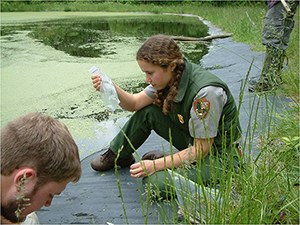
Natural resource inventories provide solid baseline data for long-term monitoring and management and allow for comparisons between existing and desired conditions.
The Inventory & Monitoring Division's Inventory Program funds projects driven by and tailored to park needs. The focus is currently on the collection of new data on species occurrence, abundance, or distribution to inform park management decisions and planning. Once a year, park staff (or staff from their associated I&M networks, on behalf of park staff), submit proposals for review and selection by a regional panel. Additional guidance can be found on the Inventory Program's SharePoint page (NPS only).
Between 2000 and 2007, NCRN conducted a series of species inventories to fill in data gaps on species status and abundance for vertebrates and vascular plants at specific parks. In addition, a set of 12 “basic” natural resource inventories were done for all NCRN parks.
Source: NPS DataStore Collection 153. To search for additional information, visit the NPS DataStore.
12 Basic Natural Resource Inventories
Twelve basic resource inventories are intended to provide park managers with the minimum information needed to effectively manage the natural resources of their park.
- Air Quality - focuses on indicator pollutants regulated under the Clean Air Act, including ozone, particulate matter, visibility, mercury, and acid deposition of nitrogen and sulfur. Air quality data is displayed by park in an NPS Air Quality Conditions & Trends Tool and also geographically across the country.
- Air Quality Related Values - provides information on the types and amounts of air pollutants that cause harmful changes to resources including: visibility, vegetation, soils, water, fish, and wildlife. Download a 2016 report on Air Quality Related Values for National Capital Region Network Parks.
- Base Cartography - Online access to legacy and current geospatial data sets is provided by the USGS National Map and EarthExplorer, as well as the US Department of Agriculture Geospatial Data Gateway. These federal systems have superseded NPS efforts to acquire and store digital spatial data files.
- Climate - provides access to climate data on NPS lands. Access to climate data, especially in light of climate change, is fundamental to our understanding of the status of ecosystems and species and their response to climate variability. Download the full NCRN Weather and Climate Inventory report.
- Geologic Resources - provides digital geologic map data, and a park-specific geologic report. This inventory aims to raise awareness of geology and the role it plays in the environment. Full reports, data, and maps can be found at the NPS Geologic Resources Inventory Publications Page.
- Natural Resource Bibliography - Natural resource-related information products concerning national parks are managed and cataloged in the IRMA Data Store.
- Soils Resources - Data and reports on soil resources include maps of the locations and extent of soils; data about physical, chemical, and biological properties of those soils; and information about use issues for each kind of soil.
- Species Lists - The core of the species lists inventory is NPSpecies, a web-based system that provides a way to build, manage, and share park species information. NPSpecies includes standardized information on species occurrence in parks, including scientific names and their synonyms, common names, abundance, residency, nativeness, and more. Park species lists through NPSpecies are available on the NCRN website.
- Vegetation (Map) Inventory - Final products of the NPS Vegetation Inventory include classifications, descriptions, and detailed maps of vegetation communities for each park.
- Baseline Water Quality - Baseline physical, chemical, and biological water quality data that was collected, documented, and summarized from existing, readily-available, digital water quality data collected in the vicinity of parks. The primary sources used for this information were national water quality databases, such as the Environmental Protection Agency's STORET data system and the U.S. Geological Survey's National Water Information System.
- Water Body Location and Classification - A high-resolution (1:24,000, 1:63,360 in Alaska) database for 8-digit hydrologic units/sub-basins containing national park units is available as the National Hydrography Dataset. The Hydrographic and Impairment Statistics database provides water impairment summary statistics of surface hydrography (acres of lakes, miles of streams, etc.) within and adjacent to each national park unit.
Last updated: February 5, 2024
